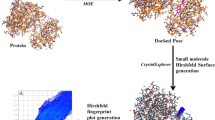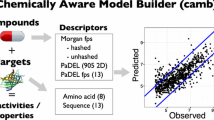Abstract
In extension and improvement of previous results, a novel method is worked out for pharmacophore identification and activity prediction in structure-activity relationships. In this method, as in our previous works, each molecular system (conformation) of the training set is described by a matrix with both electron structural parameters (atomic charges, bond orders, etc.) and interatomic distances as matrix elements. This description includes a rather full geometry of charge and/or reactivity distribution thus providing a much better representation of the molecular properties in their interaction with the target. By multiple comparison of these matrices for the active and inactive compounds of the training set, a relatively small number of matrix elements are revealed that are common for all the active compounds and are not present in the same combination in the inactive ones. In this way a set of electronic and geometry parameters is obtained that characterize the pharmacophore (Pha). A major improvement of this scheme is reached by introducing the anti-pharmacophore shielding (APS) and a proper treatment of the conformational problem. The APS is defined as molecular groups and competing charges outside the basic skeleton (the Pha plus the inert neighbor atoms that do not affect the activity) that hinder the proper docking of the Pha with the bioreceptor thus diminishing (partially or completely) the activity. A simple empirical formula is derived to estimate the relative contribution of APS numerically. Two main issues are most affected by the APS: (1) the procedure of Pha identification is essentially simplified because only a small number of molecular systems with the highest activity and simplest structures (systems without APS) should be tried for this purpose; (2) with the APS known numerically, we can make a quantitative (or semiquantitative) prediction of relative activities. The contributions of different conformations (of the same molecular system) that possess the Pha and different APS is taken into account by means of a Boltzmann distribution at given temperatures. Applied to an example, rice blast activity, this approach proved to be rather robust and efficient. In validation of the method, the screening of 39 new compounds yields approximately 100% (within experimental error) prediction probability of the activity qualitatively (yes, no), and with r2=0.66 quantitatively.
Similar content being viewed by others
References
Marshall, G.R., In Wolff, M.E. (Ed.) Burger' Medicinal Chemistry and Drug Discovery, Vol. 1, John Wiley and Sons, New York, NY, 1995, pp. 573–659.
Kubinyi, H. (Ed.) 3D QSAR in Drug Design: Theory,Methods and Applications, ESCOM, Leiden, The Netherlands, 1993.
Höltje, H.D. and Folkers, G., In Mannhold, R., Kubinyi, H. and Timmerman, H. (Eds.) Molecular Modeling: Basic Principles and Applications, VCH Publishers, New York, NY, 1997, pp. 9–61.
Cohen, N.C. (Ed.) Guidebook on Molecular Modeling in Drug Design, Academic Press, New York, NY, 1996.
Oprea, T.I. and Waller, C.L., In Lipkowitz, K.B. and Boyd, D.B. (Eds.) Review of Computational Chemistry, Vol. 11, Wiley-VCH, New York, NY, 1997, pp. 127–182.
Martin, Y.C., In Martin, Y.C. and Willett, P. (Eds.) Designing Bioactive Molecules, American Chemical Society, Washington, DC, 1998, pp. 121–148.
Greco, G., Novellino, E. and Martin, Y.C., In Lipkowitz, K.B. and Boyd, D.B. (Eds.) Review of Computational Chemistry, Vol. 11, Wiley-VCH, New York, NY, 1997, pp. 183–240.
Jurs, P.C., Chou, J.T. and Yuan, M., In Olson, E.C. and Christofferson, R.E. (Eds.) Computer-Assisted Drug Design, ACS Symposium Series 112, American Chemical Society, Washington, DC, 1979, pp. 103–129.
Doucet, J.P. and Weber, J., Computer-Aided Molecular Design: Theory and Applications, Academic Press, San Diego, CA, 1996, pp. 364–404.
Bersuker, I.B. and Dimoglo, A.S., In Lipkowitz, K.B. and Boyd, D.B. (Eds.) Review of Computational Chemistry, Vol. 2, VCH, New York, NY, 1991, pp. 423–460.
Bersuker, I.B., Dimoglo, A.S., Gorbachov, M.Yu., Pesaro, M. and Vlad, P.F., New J. Chem., 15 (1991) 307.
Bersuker, I.B., Dimoglo, A.S. and Gorbachov, M.Yu., Nahrung-Food, 32 (1988) 461.
Bersuker, I.B., Dimoglo, A.S. and Gorbachov, M.Yu., Nahrung-Food, 33 (1989) 405.
Bersuker, I.B., Dimoglo, A.S. and Gorbachov, M.Yu., In Hadzi, D. and Jerman-Blazic, B. (Eds.) QSAR in Drug Design and Toxicology, Vol. 10, Elsevier, Amsterdam, 1987, pp. 43–48.
Bersuker, I.B., Dimoglo, A.S., Gorbachov, M.Yu., Vlad, P.F. and Koltsa, M.N., In Hadzi, D. and Jerman-Blazic, B. (Eds.) QSAR in Drug Design and Toxicology, Vol. 10, Elsevier, Amsterdam, 1987, pp. 340–342.
Bersuker, I.B., Dimoglo, A.S. and Gorbachov, M.Yu., Bioorgan. Khim., 13 (1987) 38.
Bersuker, I.B. and Dimoglo, A.S., In First World Congress on the Health Significance of Garlic and Garlic Constituents, Washington, DC, 1990.
Dimoglo, A.S., Bersuker, I.B., Popa, D.P. and Kuchkova, K.I., Theor. I Eksp. Khim., 5 (1989) 590.
Dimoglo, A.S., Vlad, P.F., Shvets, N.M., Koltsa, M.N., Guzel, Y., Saracoglu, M., Saripinar, E. and Patat, S., New. J. Chem., 19 (1995) 1217.
Dimoglo, A.S., Beda, A.A., Shvets, N.M., Gorbachov, M.Yu., Kheifits, L.A. and Aulchenko, I.S., New. J. Chem., 19 (1995) 149.
Guzel, Y., J. Mol. Struct. (Theochem), 366 (1996) 131.
Guzel, Y., Saripinar, E. and Yildirim, I., J. Mol. Struct. (Theochem), 418 (1997) 83.
Kansy, M., Ulmshneider, M. and van de Waterbeemd, H., In Sanz, I., Giraldo, J. and Manaut, F. (Eds.), QSAR and Modelling: Concepts, Computational Tools and Biological Applications, Prous Science Publishers, Barcelona, Spain, 1995, pp. 633–638.
Fukui, K., Theory of Orientation and Stereoselection, Springer-Verlag, Berlin, 1975, p. 134.
Klopman, G., In Klopman, G. (Ed.) Chemical Reactivity and Reaction Paths, Wiley, New York, NY, 1974, pp. 55–165.
Pearlman, R.S., In Kubinyi, H. (Ed.) 3D QSAR in Drug Design: Theory, Methods and Applications, ESCOM, Leiden, 1993, pp. 41–79.
SPARTAN, V. 5.0.3, Wavefunction, Inc., Irvine, CA, 1997.
MATLAB, V. 5.2.1, Mathworks, Inc., Natick, MA, 1998.
Dreikorn, B.A. and Thibault, T.D., Triazolo(4,3a)quinoxalines for the Control of Rice Blast, US Patent 4,008,322, 1977.
Dreikorn, B.A and Durst, G.L., In Baker, D.R., Fenyes, J.G. and Basarab, G.S. (Eds.) Synthesis and Chemistry of Agrochemicals IV, ACS Symposium Series 584, American Chemical Society, Washington, DC, 1995, pp. 354–374.
Author information
Authors and Affiliations
Rights and permissions
About this article
Cite this article
Bersuker, I.B., Bahceci, S., Boggs, J.E. et al. An electron-conformational method of identification of pharmacophore and anti-pharmacophore shielding: Application to rice blast activity. J Comput Aided Mol Des 13, 419–434 (1999). https://doi.org/10.1023/A:1008052914704
Issue Date:
DOI: https://doi.org/10.1023/A:1008052914704




